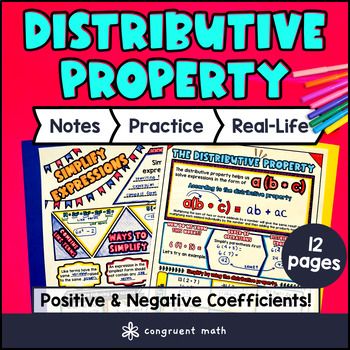Want more ideas and freebies?
Get my free resource library with digital & print activities—plus tips over email.
Join for Free Resources →
$4.25
Have you ever wondered how to teach distributive property to 6th graders?
Use this artistic lesson plan to teach your 6th grade students about the distributive property. Students will learn the material with artistic, interactive guided notes (similar to sketch notes), check for understanding, and practice with a worksheet and color by number.
The lesson concludes with the real-life application of the distributive property for grocery shopping and recipes. Students learn to apply the distributive property to easily scale recipes, calculate discounts, and compare prices at the grocery store.

$4.25
After this lesson, students will be able to:
Note: This lesson covers positive integer coefficients only. See extensions for harder practice!
Before this lesson, students should be familiar with:
If you’re looking for digital practice for the distributive property, try my Pixel Art activities in Google Sheets. Every answer is automatically checked, and correct answers unlock parts of a mystery picture. There’s different versions depending on your students' needs:
A fun, no-prep way to practice the distributive property is Doodle & Color by Number — it's a fresh take on color by number or color by code. It includes 3 levels of practice, and there's different versions depending on your students' needs:
The distributive property is a mathematical rule that says that you can multiply a single term by a group of terms inside a set of parentheses, and the result will be the same as if you had multiplied each term inside the parentheses separately and then added the results together. This property is often used to simplify algebraic expressions.
The distributive property works because it allows you to distribute a factor to all terms within a set of parentheses, making it easier to simplify expressions. This mathematical rule is a way to break down complex expressions into simpler ones. Applying the distributive property to an expression like 3 * (2 + 4) allows us to simplify it to 3 * 2 + 3 * 4. Distributing the 3 to both terms inside the parentheses results in the same value. We can then simplify further to get 6 + 12 = 18. Thus, 3 * (2 + 4) and 3 * 2 + 3 * 4 both equal 18, proving the distributive property.
To use the distributive property to simplify expressions, follow these steps:
For example, if you have the expression 3(x + 2), you would:
3x and 23(x) + 3(2)3x + 6If you have students that need more of a visual explanation, I find this Khan Academy video helpful:
The distributive property is an important concept in math because it allows us to break down complicated problems into smaller, more manageable parts. This not only makes math easier to understand, but it also helps us solve problems more efficiently. Additionally, the distributive property is used in many real-world situations, such as scaling recipes and calculating discounts.
Here are some common mistakes to avoid when using the distributive property:
x and 2 in the expression 3(x + 2)3 to only x and not 2 in the expression 3(x + 2)3(x + 2) as is after distributing the factor 3The distributive property is a fundamental concept in mathematics that has numerous real-life applications. Here are some examples:
These are just a few examples of the real-life applications of the distributive property. The concept is widely used in many fields and can be applied to a variety of situations.
The distributive property can be used to scale recipes by multiplying the quantities of the ingredients within a recipe by a common factor. For example, suppose a recipe needs 2 cups of flour, 1 cup of sugar, and 1/2 cup of butter to make 12 cookies. If you want to make 24 cookies, you can use the distributive property to double the quantities of each ingredient: 4 cups of flour, 2 cups of sugar, and 1 cup of butter.
In general, if a recipe serves n people and you want to serve m people instead, you can scale the recipe by multiplying the quantities of each ingredient by m/n.
By using the distributive property to scale recipes, you can easily adjust the ingredients based on the number of servings you need. Here’s a step by step example:
Get my free resource library with digital & print activities—plus tips over email.
Join for Free Resources →